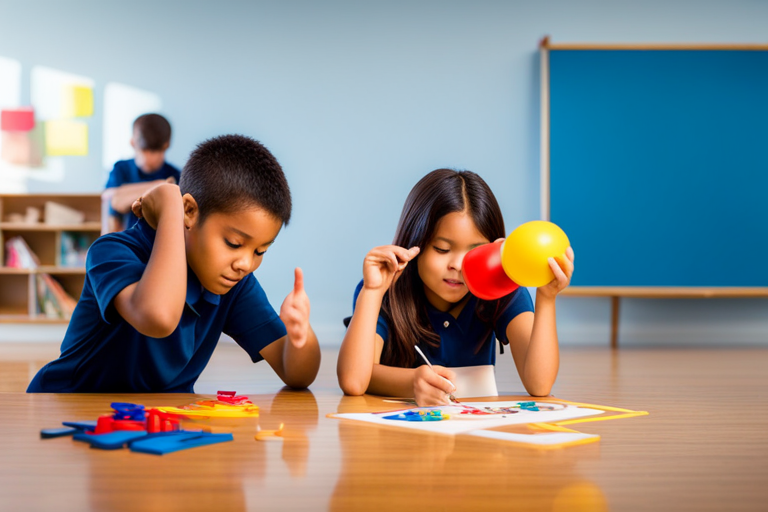A good teacher knows that keeping students engaged is essential for effective and enjoyable learning. It isn't always easy to capture students' attention and ensure that they are focused on the content, especially in today's digital age, filled with distractions. However, I believe the key to success lies in creating a fun and interactive learning environment. When I started incorporating games, debates, and group activities into my lessons, I noticed an immediate improvement in my students' participation and understanding. That's why I've put together this list of ideas for fun and engaging activities for interactive learning in the classroom. These activities not only make learning more enjoyable but also help students retain information as they work collaboratively and engage with the material in different ways. From scavenger hunts to skits, there's something for every teacher looking to add an element of excitement to their lessons. So, let's dive in and discover some new and exciting ways to make learning come alive in the classroom!
Creating a scavenger hunt to work collaboratively and learn from each other is an exceptional idea that combines learning with fun activities. Scavenger hunts are an incredible teaching tool to help students engage and participate actively in group activities. Here are some tips and tricks on how to make a scavenger hunt enjoyable and unforgettable for your students while sticking to keyword “Fun activities.”
1. Create a theme: Choose a theme that aligns with your lesson or unit of study. For instance, if you are teaching a unit on the environment, make a scavenger hunt that focuses on recycling, renewable energy, and sustainability.
2. Be creative: Add pictures, riddles, and clues to make the scavenger hunt more engaging and interactive. You can also hide the clues in various locations around the school or classroom to make it more challenging.
3. Divide students into groups: Divide the students into small groups and assign each group a specific color or object. This way, students can work collaboratively in their groups to find the clues and complete the scavenger hunt.
4. Incorporate technology: Utilize technology by using QR codes or interactive apps to guide students through the scavenger hunt. This way, students can explore the school or classroom while using their mobile phones or tablets.
5. Offer rewards: Students enjoy receiving rewards for their hard work and effort. Offer small prizes such as stickers, pencils, certificates to the winning group.
The creation of a scavenger hunt as a way to work collaboratively and learn from each other is an amazing idea that engages, engages, and engages students through fun activities. By incorporating a theme, being creative, dividing students into groups, incorporating technology, and offering rewards, you can make a scavenger hunt that your students will remember forever.
Play a game of Jeopardy to review key concepts
Playing a game of Jeopardy to review key concepts related to fun activities is an innovative and exciting way to engage learners in the subject matter. This interactive game not only promotes active learning but also provides a fun and competitive environment for learners to recall important concepts. Here are some tips and tricks to make this idea successful:
1. Develop a Jeopardy board: create a Jeopardy board that includes different categories related to fun activities such as team building, outdoor activities, indoor games, adventure sports.
2. Create questions: formulate questions related to each category, focusing on different levels of difficulty based on the learners' knowledge.
3. Divide into Teams: divide learners into teams and have them select a team name to increase engagement.
4. Set a Timer: Set a timer for each question to keep the game moving swiftly and add to the excitement.
5. Keep Score: Assign points for each correct answer, and keep score throughout the game. Declare the winning team after the final question.
6. Incorporate multimedia: Incorporate multimedia components such as pictures or videos to provide visual stimulation and increase engagement and excitement levels.
7. Reward the Winners: Offer a fun and exciting prize for the winning team to boost motivation and engagement.
The game of Jeopardy, when played to review key concepts related to fun activities, promotes interactive learning, challenges learners, and increases engagement. By following these seven tips and tricks, you can create an educational experience that is both enjoyable and effective in reinforcing concepts and retaining information.
Utilize a Kahoot quiz to assess student understanding
Utilizing a Kahoot quiz to assess student understanding of Fun activities is a creative and attractive idea that is sure to engage and excite learners. By incorporating interactive learning methods and classroom games, students are more likely to remember and understand the material being presented. Here are some tips and tricks on how to effectively implement this idea:
1. Keep it engaging: Incorporate as many fun and exciting elements as possible in the quiz. Use bright colors, graphics, and sound effects to make the quiz more interesting.
2. Keep it interactive: Encourage student participation by making the quiz interactive. Ask for student feedback and let them share their own perspectives.
3. Collaborative learning: Create groups and let them work together to come up with the right answers. This not only encourages collaboration but also allows students to learn from one another.
4. Student engagement: Encourage students to stay engaged and attentive during the quiz by making it challenging yet fun. Use humor if possible and keep the language simple and understandable.
5. Incorporate multiple-choice questions: Using multiple-choice questions is an effective way to test student understanding. It allows them to think creatively and critically about the topic.
6. Feedback and assessment: Let students know the scores of the quiz immediately. Offer feedback on their responses and highlight areas where they need to improve.
7. Fun learning: Finally, make sure the objective of the quiz is to create a fun, engaging learning environment. Students are more likely to learn and remember information if they have fun doing so!
By following these tips and tricks, you can create an exciting and interactive learning experience for your students while assessing their understanding of fun activities.
Incorporate a debate to introduce a topic
Tips and tricks for incorporating a debate to introduce a topic related to Fun activities:
1. Choose a relevant and interesting topic related to Fun activities, such as the benefits of team building activities the pros cons of adventure sports.
2. Formulate a debate prompt that can be argued from different perspectives. For example, “Are extreme sports worth the risk?” or “Do virtual reality games provide a better experience than real-life activities?”
3. Divide the participants into two teams and assign them roles, such as pro and con or advocate and critic. Each team should have equal time to prepare their arguments and counterarguments.
4. Set clear rules for the debate, such as the time limit for each speaker, the use of evidence and examples, and respectful behavior towards each other.
5. Encourage active participation and engagement of all participants, including those who may not feel confident in public speaking or debating. Allow for questions and feedback from the audience.
6. Conclude the debate by summarizing the main points and highlighting the different perspectives and opinions presented. Encourage the participants to continue the discussion and explore the topic further.
7. Follow up with related Fun activities that the participants can enjoy together, such as team-building games, adventure sports, or virtual reality experiences. Use the debate as a way to generate ideas and interest in Fun activities that promote learning, socializing, and creativity.
Have students create a skit to demonstrate a concept
Creating a skit to demonstrate a concept is an engaging and creative way to deepen students' understanding of a particular topic. This fun activity helps to bring learning to life and make it fun and interactive. By giving students the opportunity to use their creativity and imagination, they not only have fun but also improve their problem-solving and critical thinking skills. Here are some tips and tricks on how to create a skit to demonstrate a concept:
1. Choose a concept: Choose a topic that aligns with your lesson plan. Make sure you have taught the concept well enough to the students before letting them create a skit.
2. Assign roles: Assign roles to the students such as actor, director, assistant director, writer. Ensure that every student has a role to play to encourage participation and engagement.
3. Research and create a script: Ask the students to research on the concept and develop a script. Encourage creativity and engagement as they come up with ideas.
4. Rehearse: The students should practise the skit as often as possible. You can schedule practice sessions in class or after-school to ensure that everything runs smoothly during the actual performance.
5. Get props: Engage the students in the process of collecting materials/props that will enhance their skit.
6. Organize the performance: Once everything is ready, organize for the performance. You can have other students or teachers as the audience or other classes in the school.
7. Evaluate the performance: Evaluate the students' performance, provide feedback, and celebrate their success.
The process of creating a skit to illustrate a concept offers students an opportunity to demonstrate their creativity and problem-solving abilities. This activity helps to break the monotony of classroom learning and makes the lesson more engaging and interactive. Give it a try, and you'll be glad you did.
Divide students into groups to discuss a problem and present solutions
1. Have a clear discussion topic: To ensure a focused and productive session, provide clear guidelines and discussion topics to the students. This could be a current event, case study, or a hypothetical scenario.
2. Create diverse groups: Mix up the groups to ensure that students are exposed to different perspectives, experiences, and expertise. Randomizing the grouping process can sometimes lead to rewarding and meaningful discussions.
3. Set clear goals and expectations: Ensure students are aware of what is expected of them during the discussion. This could include ground rules, time limits, and guidelines for presenting solutions.
4. Incorporate interactive tools: Use interactive online tools such as a shared Google doc digital whiteboard to encourage collaboration active participation.
5. Provide feedback: Encourage students to give and receive feedback in a supportive and constructive manner. This is an opportunity to build communication and teamwork skills.
6. Make it fun: Experiment with creative approaches to make the activity engaging, enjoyable, and memorable. This could include games, role-playing, or adding a competitive element.
7. Celebrate achievements: Recognize and celebrate the contribution of each group and individual. You could hold a mini award ceremony or share positive feedback with the class.
By following these tips and tricks, students can enjoy fun activities while learning how to effectively collaborate and find solutions to problems.
Assign a project to have students create a presentation
The assignment of a project that requires students to create a presentation is a fun and creative way to get them involved while also helping them learn essential skills at the same time. All grade levels and subjects are able to make presentations on a variety of subjects, so this idea is applicable to all of them. By allowing students to express their creativity and present their ideas in an exciting manner, you can keep them engaged and motivated throughout the learning process.
Here are some tips and tricks that you can consider when assigning a presentation project to your students.
1. Provide a clear objective: Before starting the project, make sure to explain the objective so that students know what they are expected to do.
2. Set clear guidelines: Provide students with clear guidelines on the content of the presentation, the length, and any other requirements you may have in mind.
3. Allow for creativity: Encourage students to use their creativity by allowing them to choose their presentation format and style. For example, they could create a Prezi, PowerPoint, or even a video.
4. Include collaboration: Assigning group projects encourages collaboration between students and helps to foster a team spirit.
5. Provide resources: Provide students with resources such as online videos tutorials that they can use to assist them in creating their presentations.
6. Encourage practice: Give students ample time to practice their presentations in front of their peers or even in front of you. This will help them become more confident in their speaking skills.
7. Provide feedback: Provide positive feedback to students on their presentations and make suggestions for improvement. This will help them develop their skills and improve their presentations.
8. Reward creativity: Consider rewarding creativity by giving out awards or bonuses for the most creative or informative presentations.
It is a fun and creative way to engage students in the learning process by assigning a project that requires them to create a presentation. By providing clear guidelines and encouraging creativity, you can keep them motivated and interested throughout the project. Don't forget to reward creativity and provide positive feedback to help your students improve their presentations.
Organize a field trip to a relevant location
. Choose a relevant location: The first step in organizing a field trip is to choose a location that is both relevant to your group and fun to visit. For example, a science class might consider visiting a local research lab, while a history class might enjoy a trip to a nearby museum.
2. Plan ahead: Once you have selected a location, be sure to plan ahead. Make reservations, gather necessary permissions, and ensure that transportation is arranged. Having a backup plan in case of unexpected changes is also a good idea.
3. Include fun activities: To make your field trip more engaging and enjoyable, include fun activities that are related to the location. For example, a trip to a zoo could include a scavenger hunt or a chance to feed the animals. A visit to a historical site might include a reenactment or a hands-on workshop.
4. Be flexible: Field trips can be unpredictable, so it's important to be flexible. Allow for extra time, be prepared for delays, and be willing to adjust plans as needed. Remember to focus on having fun and enjoying the experience rather than sticking too strictly to a schedule.
5. Encourage participation: Encourage participation by providing opportunities for students to ask questions, share their thoughts, and engage with the location. Allow for moments of exploration and discovery, and encourage students to take the lead in their learning.
It can be a great idea to organize a field trip to a relevant location to add some fun activities to your learning process. Be sure to plan ahead, include engaging activities, and be flexible to make the most out of your trip.
Cooperate with another class to create a shared project
Tips and Tricks for Cooperating with Another Class to Create a Shared Project:
1. Plan ahead: Set aside some time for a brainstorming session with the teacher(s) of the other class. Take time to discuss ideas, goals, and expectations.
2. Assign roles: Assign project roles and delegate responsibility. Discuss everyone's strengths and interests, to ensure everyone has a role that matches their skills.
3. Communicate regularly: Make sure to communicate regularly with the other class via email, phone, or video conference. Keep each other updated on progress, ideas, and any issues that arise.
4. Make it fun: Incorporate fun activities into the project – such as a scavenger hunt an art project. This will help to keep everyone motivated and engaged.
5. Celebrate success: Celebrate project milestones and achievements with both classes. This will help to build morale and encourage everyone to keep working hard.
6. Work together: Encourage both classes to work together on the project, whether that's collaborating on documents, brainstorming ideas, or simply being available for support.
7. Reflect: Take time to reflect on the project. What worked well? What could have been improved? What would you do differently next time?
Taking part in a shared project with another class can be an enjoyable and rewarding experience. With some careful planning, effective communication, and a few fun activities, you can create a memorable project that everyone will be proud of.
Have students teach each other a concept or skill
Tips and Tricks for Having Students Teach Each Other a Concept or Skill through Fun Activities:
1. Clap It Out – To teach spelling and word recognition, have students play a game where one starts by spelling a word out loud, then the next student repeats the word and adds another letter until the word is complete.
2. Brain Break Charades – Take a quick break with fun charades that can reinforce content-area vocabulary and ideas.
3. Math Mime – Have students act out different math problems.
4. Scoot – Create stations or problems on index cards and students rotate through all of them during a given time period.
5. Speed Dating – Partner up students and have them explain a concept to each other before rotating pairings.
6. Trivia Bowl – Create trivia questions about a lesson topic and have students answer in teams.
7. Exit Ticket – Have students teach a concept or skill to a classmate before leaving the classroom.
8. Jigsaw – Divide students into small groups and assign each group an aspect of a larger concept, then have them present their findings to the class.
9. Gallery Walk – Students rotate around the classroom studying different displays of information on a topic before returning to their original groups.
10. Think-Pair-Share – One student begins by explaining a concept, breaking it down piece by piece, and then works with a partner to expand upon the idea.
By providing students with the opportunity to teach their classmates, they are able to not only reinforce their own knowledge but also develop the ability to communicate effectively and build better interpersonal connections with their peers. Using fun activities helps to create an engaging and motivating learning environment, ultimately benefiting the entire class.
Conclusion
The learning process can be made more enjoyable by including fun and engaging activities in the classroom, as well as helping students retain information better by doing so. The use of interactive learning promotes collaboration, creativity, and critical thinking among students through scavenger hunts, debates, and skits. Games like Jeopardy and Kahoot can also be utilized to review and assess student progress. By introducing such activities, teachers can give their students the opportunity to learn in a more engaging, memorable way. As a reader, you can take away the significance of incorporating fun and engaging activities in your classroom to enhance your teaching techniques and facilitate better learning outcomes for your students.






